It may be possible to revitalise Hong Kong villages so they still have rural character and are great places to live – and visit.
Travel through rural Hong Kong, and while there’s much to appreciate, you soon realise this is a troubled paradise. The hills, valleys, woods and waterfalls are wonderful, and Hong Kongers can be justly proud of the country park system. But visit and pass close by villages, and you might find some are almost deserted, with houses crumbling to ruins; or – more typically – dominated by higgledy-piggledy clusters of three-storey “Spanish” villas, near bereft of rural charm.
It’s a great contrast to the situation in many other parts of the world. Like in a national park near my hometown in Yorkshire, England – where tourists flock to villages of stone houses that ooze rural charm, buying souvenirs in small shops and enjoying afternoon tea in cafes with outdoor seating for spells when it isn’t raining. Even in Cape Town, South Africa, I’ve been to villages with laidback appeal – safeguarded partly by guidelines on heritage conservation.
In somewhere like Yorkshire, Cape Town or even parts of mainland China, villages akin to the best remaining in Hong Kong would surely attract official conservation efforts. But here, they’re mostly just left to chance. Consider, for example, Pak Sha O.
Pak Sha O
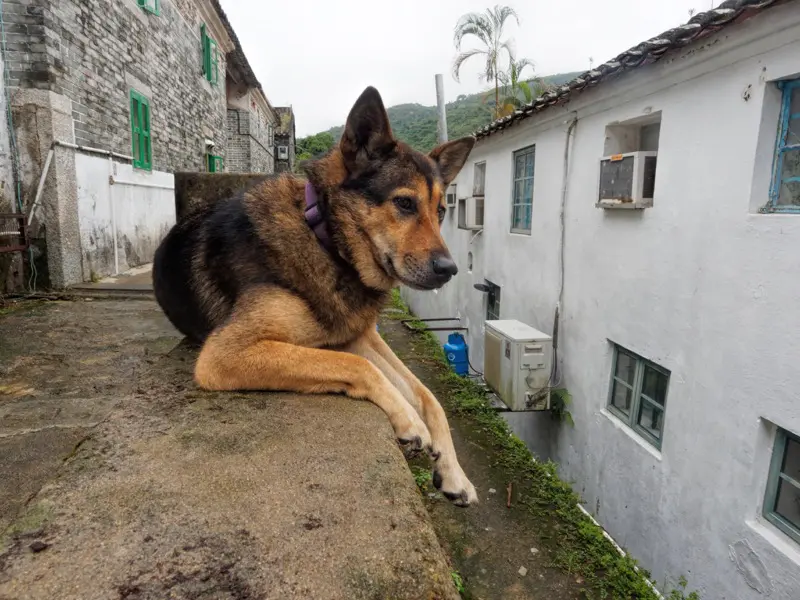
Nestled in a valley in the northeastern Sai Kung Peninsula, Pak Sha O comprises two-storey houses arrayed in terraces, without a Spanish style villa in sight. As is typical of the more remote villages, it was largely abandoned in the 1970s, with indigenous villagers heading to the city and even overseas in search of a better living.
Empty buildings fell into disrepair, with some walls and roofs collapsing, but in the past couple of decades several outsiders have moved in, renting and lovingly renovating houses. To historian Patrick Hase, Pak Sha O and neighbouring Ha Yeung are, “Two of the finest villages in the New Territories, and well worth preserving.”
Though it includes a grade one listed building, there are no plans for preserving Pak Sha O, no guidelines for retaining its character. Official zoning – like where buildings are permitted, or farming is allowed – seems to be all that might conserve the area, thwarting at least some of the plans of a developer who has bought much of the land and is evidently keen to build housing that’s ostensibly for former residents, yet may really target affluent city people who fancy a place in the suburbs.
Elsewhere, arguments rage over a host of other villages – that is, where they aren’t already complete ruins, or transformed by Spanish villas. Often, they evidently hinge on money, with the small house policy introduced in the 1970s having morphed into something unintended: no longer is it simply for male indigenous villagers to build homes for themselves, but it also affords opportunities to build apartments and houses for profit. And the “small houses” have proliferated, transforming the countryside, seemingly built with little or no regard for creating the sort of close-knot communities that once typified Hong Kong.
There are, however, some people and projects that suggest there could be another way. It may be possible to revitalise villages so they still have rural character and are great places to live – and visit. But don’t go cheering just yet – this might only work in few places, and even then the chances of success are slim. And, lest a high level official happen to read this, government support would be really, really invaluable.
Hok Tau – pioneering organic farming
If it’s to be more than a quaint dormitory suburb, any revitalised village must provide opportunities to generate income. Farming seems one obvious solution. Yet a huge reason that many villages have become quieter or even deserted since the 1970s is that farming has become uneconomic thanks to cheaper food imports, and more challenging for many places as stream flows were diverted to reservoirs. Even so, there has been something of a resurgence in farming, with a strong emphasis on organic produce – pioneered at Hok Tau by a few dedicated individuals including Simon Chau Sui-cheong, co-founder of environmental group Green Power.
“Looking back 28 years, after we founded Green Power, a group friends and myself wanted to hold meetings, enjoy nature, and do something on land,” Chau recalls. “We consulted the Agriculture and Fisheries Department, and there was new scheme for rejuvenation of abandoned farmland. We found a place at Hok Tau near Fanling, where we could pay to use the land.”
Chau and his friends established the first organic farm in Hong Kong, run by a charitable organisation, Produce Green Foundation. They were also the first to invite “weekend farmers”, who rented small plots – and without whom, says Chau, “It was impossible to survive by only growing and selling.” Nowadays, Produce Green mainly relies on income from coachloads of visitors including schoolchildren, and while Chau says there are up to 300 organic farms in Hong Kong (the Agriculture, Fisheries and Conservation Department [AFCD] reports 547 organic farms as of May this year), most are small, barely surviving, and many people have left disillusioned.
“Landlords are practical, money minded; it’s money, money, money,” says Chan. “They typically don’t want proper farming to be successful, as it’s harder to get the government to change land use so they can build, and make huge profits.”
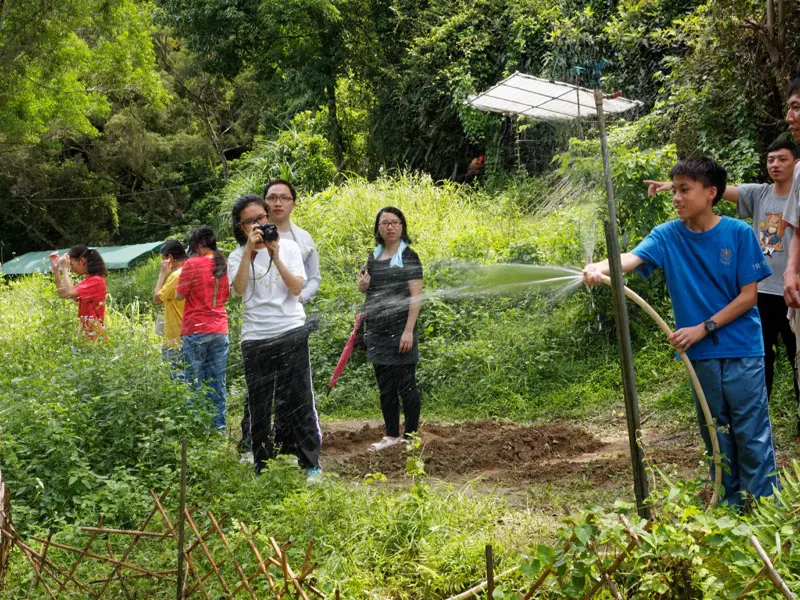
I visit the Produce Green farm at Hok Tau, and wander past small plots with vegetables, on slopes above a valley floor with rice paddies covering an area that looks barely larger than three or four badminton courts. The rice is full grown, ready for the summer harvest. A group of schoolchildren are at tables beneath a metal roof, learning to make bread by hand, while another group are taught how to prepare soil for vegetable planting, then have fun spraying a tiny field with a hosepipe.
Vicky Lau Yuen-yee, executive secretary of Produce Green Foundation, tells me a little of the farm’s history, and connections to neighbouring Hok Tau village. “We have reasonably good relationship with the villagers,” she says. “About 26 years ago, the leases were much longer, with the old people – who would come and see how we do things, cared about their land.” Initially, two villagers worked on the farm, but after they passed away, none of the younger generation have done so. The foundation now rents from the younger generation, and finds they may not know exactly where their plots are, and have to ask when they visit the farm.
Most of the farm workers are young people from relatively close places – Sheung Shui, Fanling, and Tai Po, and while they may really enjoy farming, Lau says it is hard to recruit sufficient staff, and there’s always a problem getting sufficient funding. There used to be more student visitors, but numbers have dwindled, maybe as there are different kinds of activities in schools. Corporate sponsorship partly makes up for the shortfall in revenue, such as when a company’s staff harvest rice that is later given to underprivileged people.
To me, these giveaways reflect idealism rather than business orientation. Yet even for organic farmers focused on selling produce, there are challenges in Hong Kong. Chau says there’s an “absurd” price differential between organic and regular produce, due to cheap imports from China and elsewhere, along with local turnover remaining minimal. Nor is organic farming well organised here, though the AFCD has introduced an Organic Farming Support Service, through which some 282 farms get assistance including with distribution through supermarkets, health food stores, we markets and farmers’ markets. Plus certification is only on a voluntary basis, leading to some pesticide-laced vegetables being passed off as “organic”.
But another threat looms for Produce Green’s Hok Tau farm: a village house will be built, right in the midst of the rice farming area. “The family came back from England, and they don’t have any other land,” explains Lau. “Also, the son is coming back and wants to build a house for his family. I can’t say no to that. It’s very worrying; I don’t know what kind of chaos will come.”
Maybe the new family and the farmers can somehow find future harmony. But it already strikes me as sad that after all these years, the farm and village remain separate, the farmers still considered outsiders. And while Produce Green helps show organic farming can be viable, no idyllic revitalisation is underway at Hok Tau village. I look across abandoned fields, and find views of the old houses are obscured by a row of five three-storey houses that are under construction. I wonder if they comprise a single project, and are really intended as homes for commuting city people. Whatever the answer, to my eyes they appear soulless.
Yet the Produce Green farm continues, with Lau introducing changes like coffee trees that might thrive in shady areas. “Do you still enjoy it?” I ask her.
“Of course!” she says. “This is a nice place, actually.”
Yi O – rice farming returns
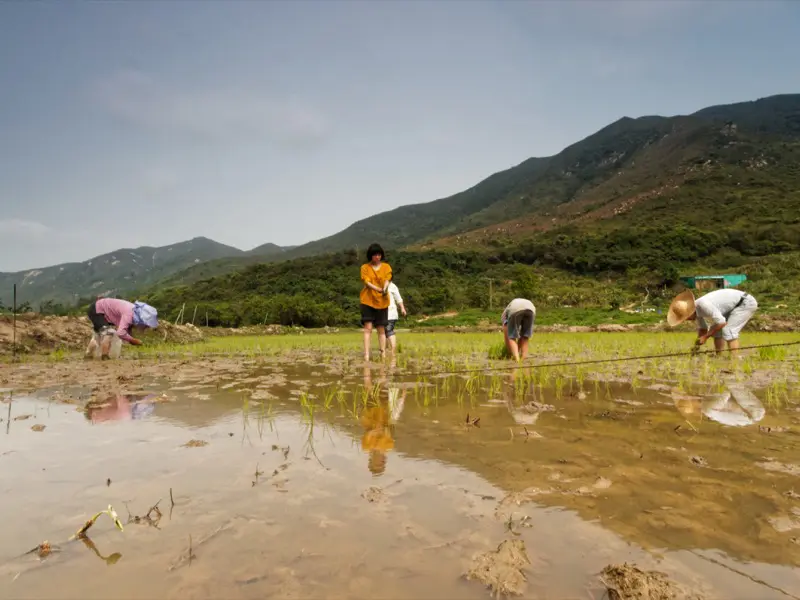
On the southwest coast of Lantau Island, there’s another farming and revitalisation project at Yi O, which at times has seemed intent on not being a nice place. Notably in 2001, by which time there was little left of the original village save the walls of the ancestor hall and school, and even the “new” village was empty houses amidst encroaching jungle – yet some former residents became aggrieved by environmentalists who planted mangroves, and blockaded the stretch of Lantau Trail passing through the area.
The blockade was quietly lifted, but more controversy flared in 2012, when trailside signs appeared, warning of “Danger”, and announcing there could be no unauthorised access. Workers with bulldozers and excavators arrived, and cleared swathes of land. I was among environmentalists outraged by what seemed wanton damage. Though I have since found the project staff friendly and welcoming, former residents still sometimes put up notices saying any visitor will be treated as a thief and reported to the police.
So the Yi O project is a curious one. Even the project founder might seem an unlikely fellow – former town planner Andrew Lam Siu-lo, whom the Post has described as “a top government adviser and Chief Executive Leung Chun-ying supporter”. It turns out, however, that Lam is no newcomer to farming ventures.
During “a quarter of a century” as a town planner, Lam worked on projects in urban and rural Hong Kong. “I’m one of few people who’ve been to every corner of Hong Kong, including for border studies,” he says. His experiences and understanding of rural areas, including the small house policy, got him thinking about planning. Hong Kong has a unique system of urban and rural development, and he wondered why there could’t be combined planning – without which we can’t manage the situation in rural areas.
In 2007, Lam became involved with a group of people who were concerned water quality, and started work on a new technology for dealing with organic pollutants including sewage. “I began studies with a partner in Zhongshan,” he says. “We had an experimental farm.” Here they could test fertiliser created in the treatment process.
“By 2010, I was serious about the business,” says Lam. “I’ve seen a lot of problems in rural areas, including China.” Believing in action rather than teaching, he supported a cooperative in Fujian – planting bamboo, along with farming in Gansu province and Chongqing. “We have experimental farms,” notes Lam. “Along with crop rotation; we raise ducks, chickens, geese, and have fishponds; basically aiming for manageable ecosystems.”
Though he considers farming more a social mission than business, Lam decided that for successful farming he should build a brand. “Hong Kong brands are still considered more trustworthy, and I think it would be easy to build a brand here, with rice,” he says. Lam searched for a suitable place in Hong Kong, which should be free of development threats, and unpolluted.
Yi O seemed promising. Lam had previously visited Yi O, and while he worked for the Urban Renewal Authority, in 2002 the village representative had visited to ask for assistance, but was told they couldn’t help.
“It wasn’t easy to get hold of that guy,” recalls Lam. “He was not easy to deal with.”
Lam learned of painful memories of an almost hand to mouth existence, and explained his concept: “I’ll invest in reactivating farming practice, and infrastructure. If I can earn anything, you’ll have your share.” The village representative helped encourage around 80 percent of the landowners to join the venture.
After two years, the Yi O project team harvested their first rice crop. Lam says the village representative’s brother and about a dozen others visited, and the representative later phoned him to say: “All my relatives were so happy; it was as the older ones saw when they were young, while the younger ones have never seen the village look like that.”
Lam reflected, “I’ve done something”, while bearing in mind the adage that happiness comes quickly, and goes quickly. Now Yi O goods are sold through a website and a small shop in Tai O. There’s more to be done, like improving harvests, enhancing the brand, rebuilding some houses, boosting income. “I’d like to see restaurants, and maybe small hostels,” says Lam.
Lai Chi Wo enjoying a new lease of life
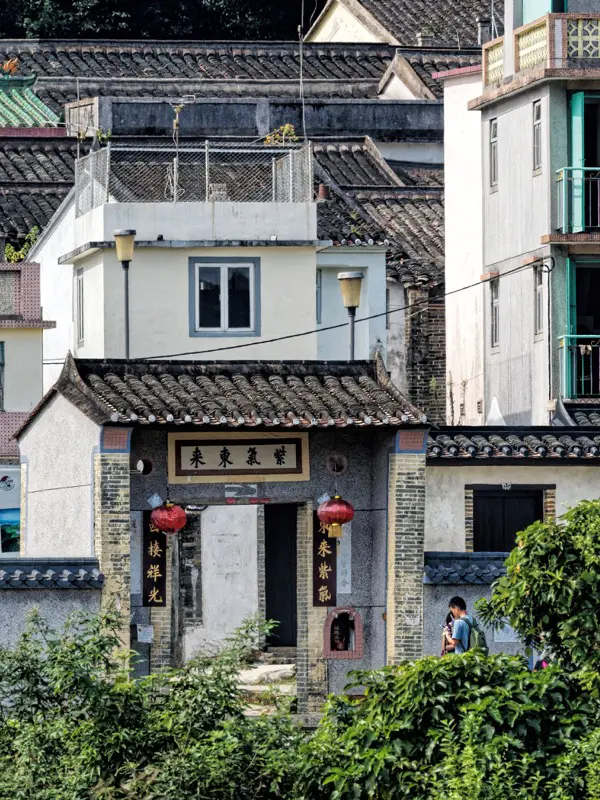
Reintroduced rice farming is likewise key to a village revitalisation scheme at Lai Chi Wo, northeast Hong Kong. While there are parallels with Yi O, this project is so far more a charitable venture. And rather as it takes a village to raise a child, here it is taking a consortium to revitalise a village.
Not that there’s an official consortium. Instead, experts in various fields are working along with financial supporters, and the University of Hong Kong’s Kadoorie Institute. “The founder of this project was Lam Chiu-ying [chairman of Hong Kong Countryside Foundation],” says Katie Chick Hiu-lai, Kadoorie Institute project manager. “He thought Lai Chi Wo was a beautiful village, and talked with interested parties such as environmentalists and villagers.” The project began with initial funding from HSBC, and advice from experts in fields spanning farming, biodiversity, marketing, culture and heritage conservation.
“The farmland had been abandoned for many years, and restoring it wasn’t easy,” says Chick. “We also aim to revitalise the community and local economic activities. The primary objective is sustainable development for the village.”
While the rice paddies still present challenges – like how to reduce amounts of water leaking away, there are encouraging signs Lai Chi Wo is enjoying a new lease of life. “Before the project, there were just one lady and a gentleman in Lai Chi Wo; both were elderly,” says Chick. “Now there are three 3 families, and we have six to seven staff living there.”
As is typical of villages that are yet to become like suburbs, Lai Chi Wo lies away from highways and railways. I join a visiting group led by project founder Lam Chiu-ying, and we travel first to Sha Tau Kok on the border with Shenzhen, before taking a speedboat “taxi” across a bay, then along past an almost deserted coastline backed by green hills, to arrive at a slender concrete pier on the shore of Yan Chau Tong (Double Haven) Marine Park.
There’s a recently built archway over the path to the village. Lam explains it was paid for by former residents who now live elsewhere, including England. The houses are neatly laid out on a gentle slope, reflecting care taken in designing the village as a whole. There’s a village wall, and a couple of cannons that are now antiques but once served to deter pirates.
Andy Tsang Shan-wah runs a tiny store from his living room, where a couple of fridges are stocked with drinks that are enticing on a hot day. He tells of leaving Lai Chi Wo with his family in 1966, and moving to Wolverhampton, England, where his father started a Chinese restaurant and take-away – complete with fare such as chips with curry sauce. He returned to Hong Kong in 2008, and now lives in Lai Chi Wo, finding it quiet initially, but now livelier.
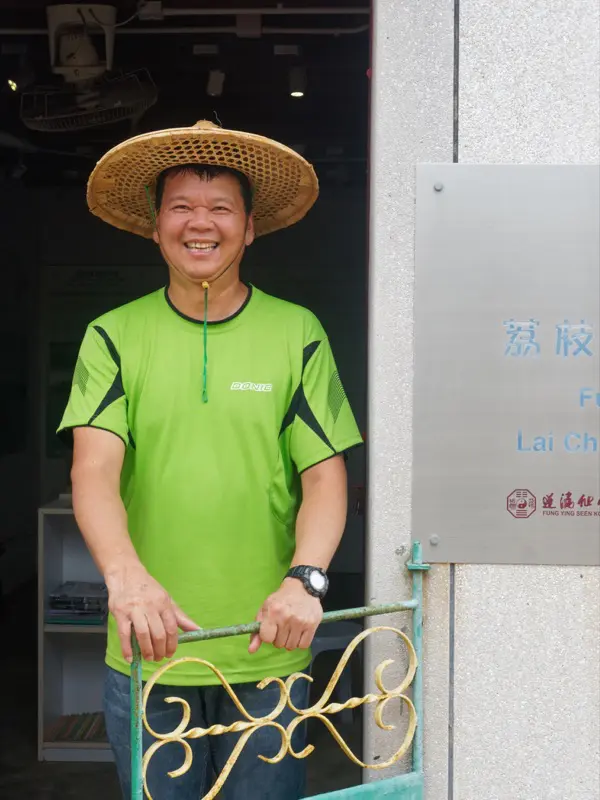
Next door is a tiny museum, set up to cover the Hong Kong Geopark, which encompasses the village and its surrounds. It’s overseen by David Tsang, who like Andy Tsang has lived in England, returning to Lai Chi Wo six years ago. “It was too quiet then,” he says. “I wanted people to come back, and live. One day, I met Mr Lam, and he had the same idea.”
Former villagers living in England meet each year, and David Tsang says none of them wanted Li Chi Wo to fall apart and become forest while the rice paddies gave way to trees. Most agreed with the planned revitalisation project, and even the few proponents of more typical development didn’t object.
While Tsang volunteers his time in the museum, he says, “I would love to make a bit of money if I can – I hope everybody who comes to live can make a little money. I’d love to have a hostel, not mainly to make money, but so people can learn about living in village. But there’s a big fine if you have a hostel without a licence; that is Hong Kong you know.”
Tsang is well aware that a resident of nearby Sam A Tsuen was fined for operating an unlicensed hostel, so declines offers to rent his house. “I tell people about the UK,” he remarks. “I travelled from north to south, and stayed in bed and breakfast places all the way.”
There’s some discussion of licensing issues for hostels and restaurants among the group led by Lam Chiu-ying. Lam is among people advocating some changes to licences designed for urban areas, so they can better suit village situations, but as yet with little success.
Katie Chick is also aware of the conundrum. How can we persuade the government?” she asks. “They’re afraid that if they loosen restrictions, it will also affect urban areas.”
To Chick, the Lai Chi Wo project is like a pilot scheme. “We are trying to find how to help villages like this,” she says. “I think the most important thing is that some local villagers understand they can work with ngos like this in developing villages. Now, some people from nearby villages are talking with us about similar projects.”
Chick is also hoping the project can help the government find a way to achieve sustainable rural development in Hong Kong. “We see potential, and think there should be a new policy or involvement in rural planning,” she says. So far, however, the government seems intent on lending tacit support to the small house policy transforming villages into shambolic suburbs, whilst staying firmly on the sidelines as a band of enthusiasts strive to maintain Hong Kong’s remaining rural charm.
Written for the South China Morning Post Sunday magazine.
